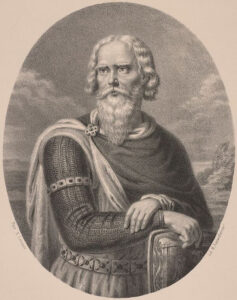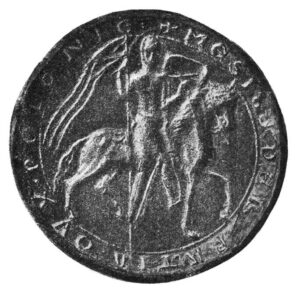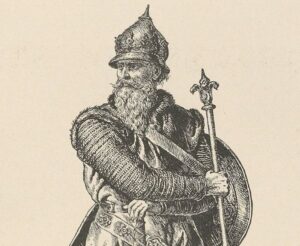We know little about her, but her name is enough to spark curiosity. She became the wife of Mieszko the Old, one of the most powerful Piast princes. How did she arrive at the Polish court? What do the chronicles say about her?
First Wife of the Prince
Mieszko III the Old married twice. His first wife, as contemporary written sources described her, was a daughter of the King of Hungary named Elizabeth. To this day, scholars have not determined the princess’s precise origins. The only certainty is that Elizabeth was not the daughter of King Béla II the Blind, as Jan Długosz suggested in the fifteenth century. Until recently, most historians believed that Mieszko the Old’s wife was the daughter of Duke Álmos, father of Béla II. The problem, however, is that sources clearly refer to Álmos as the Duke of Hungary, so this possibility must be ruled out. Kazimierz Jasiński may have been much closer to the truth, proposing that the Árpád princess was the daughter of King Stephen II, Béla’s predecessor on the Hungarian throne. Although sources recorded that Stephen, due to his dissolute lifestyle, had no offspring, Jasiński argued that these accounts are not trustworthy, given their late provenance.
Elizabeth lived with Mieszko for about fifteen years. During that time, she bore him two sons and three daughters. The eldest son was Odon, later Duke of Poznań, and the younger, Stephen, died young. Elizabeth’s daughters made excellent matches. Wierzchosława became the wife of Frederick I, Duke of Lorraine; Elizabeth married Soběslav II of Bohemia; and Judith wed Bernard III, Duke of Saxony and Count of Anhalt. Elizabeth most likely died between 1151 and 1154; the exact date of her death remains unknown.

A New Marriage
It is unclear how long Mieszko the Old mourned his wife’s passing. It could have lasted several years, if we accept the historians’ dating of his second marriage between 1151 and 1159. The new chosen one of the Greater Poland prince was Eudoxia. Her name alone, very popular in the East, points to her Ruthenian origins. Contemporary sources do not specify her parentage, but based on the chronicle of Wincenty Kadłubek, who called her the daughter of the King of the Ruthenians, scholars have established that she was the daughter of Iziaslav II Mstislavich, initially Prince of Polotsk, then of Pereyaslavl, and finally Grand Prince of Kiev.
Nothing is known about Eudoxia’s mother except that she was Iziaslav’s first wife, whose name remains unknown; in 1154, Iziaslav remarried, most likely to a daughter of King Demetrius I of Georgia. Eudoxia was born around 1142. When she married Mieszko the Old, she was at least twelve years old, if not older. Eudoxia’s only sister was the unnamed wife of Rogvolod II, Prince of Polotsk; her brothers were Mstislav Iziaslavich (Prince of Pereyaslavl, Volodymyr-Volynskyi, and Grand Prince of Kiev), Yaroslav (Prince of Lutsk and Grand Prince of Kiev), and Yaropolk (Prince of Busk).
We cannot say much about the marriage of Mieszko the Old and Eudoxia. Presumably, the prince fell in love with the Ruthenian princess, and it was under her influence that he favored her children over the sons from his first marriage. Some have even suggested that Mieszko acted similarly to his father, Bolesław III Wrymouth, who grew closer to the children of Salomea than those of Zbysłava. However, there is no source evidence to support this assumption, and the appointment of Władysław the Exile as the senior of the Piast dynasty after Wrymouth’s death seems to indicate quite the opposite.
For Better and for Worse
After marrying Mieszko, Eudoxia most likely resided in Gniezno, where her husband convened important state assemblies and issued most of his documents. Meanwhile, in Kalisz and Poznań, Mieszko prepared residences for his sons. Kalisz gained particular significance, becoming one of the most important political centers of Greater Poland and, in a short time, Mieszko the Old’s favorite residence.
Eudoxia shared in her husband’s various setbacks and successes-of which the latter were numerous in Mieszko the Old’s life. In 1172, to prevent another military intervention by Frederick Barbarossa (on behalf of the sons of the late Władysław the Exile, who died in 1159), he paid the emperor an enormous tribute. The following year (1173), after the death of Bolesław IV the Curly, he became the senior of the dynasty, assuming supreme authority over the remaining Piast lands and the seniorate province of Cracow. This was undoubtedly a great distinction for the Greater Poland prince and his wife, though due to a lack of sources, we can say nothing certain about the ambitions or intentions of the lady herself.
The happiness of Mieszko and Eudoxia was short-lived, lasting only until 1177. That year, a conspiracy of Cracow nobles, in concert with Mieszko’s family (his younger brother Casimir II the Just and eldest son Odon), expelled the princely garrisons from Lesser Poland and Greater Poland. This was a devastating blow for Mieszko, who, faced with advancing enemies, was forced to flee Poland. Eudoxia and their children accompanied him into forced exile. In her darkest dreams, the princess could hardly have imagined such a turn of events for herself and her loved ones, and she likely shed more than a few tears over it.

The first stop on Eudoxia and her husband’s journey was Raciborz, where they were hosted by Mieszko Tanglefoot, a friend of Mieszko the Old. The princely couple then traveled to Bohemia and Germany, seeking help from the rulers of those lands to reclaim their lost inheritance. Unfortunately, these hopes came to nothing, prompting the couple to continue their journey. In 1181, they were received at the court of a Pomeranian prince, who later helped them in their struggle against Odon, Mieszko’s son. According to historians, Eudoxia and her husband managed to regain the lands of Gniezno and Poznań in a relatively short time.
The course of events thus turned out favorably for the Ruthenian princess, who could once again settle in her beloved Gniezno. The four-year ordeal officially came to an end. Eudoxia would never again experience anything like it. It is possible she prayed fervently to God for this outcome. She was most likely a deeply spiritual woman. Following the example of many medieval princely wives and her own husband, who was a prolific benefactor, she supported various church institutions. Among other things, she granted the Order of the Holy Sepulchre in Miechów and she was also involved in transferring St. Michael’s Hospital in Poznań to the Knights Hospitaller.
Death of Eudoxia
After regaining part of Greater Poland, Mieszko the Old undertook a series of actions to seize control of Cracow. After numerous complications, he managed to fulfill his ambitions and take possession of the coveted stronghold, but it is impossible to say whether Eudoxia lived to see this moment. The date of her death is unknown. Although the literature sometimes suggests that the Ruthenian princess outlived her husband, there is no evidence to support this. The same is true regarding the location of Eudoxia’s burial. According to researchers, she was buried in Kalisz, in the collegiate church of St. Paul, the family necropolis of Mieszko III the Old. However, if this were indeed the case, it would be reflected in written records and archaeological findings. Unfortunately, this is not so, which calls for a critical view of this theory.
It should not be forgotten, when writing her biography, that Eudoxia bore Mieszko the Old five children-three sons and two daughters. The eldest son of the princely couple was Bolesław of Greater Poland, his father’s favorite, who was being prepared to inherit Greater Poland. Unfortunately, the premature death of this promising son in the bloody Battle of Mozgawa (1195) dashed Mieszko the Old’s plans.

Eudoxia’s next son, Mieszko of Kalisz, also died young. In circumstances unknown to us, his father granted him the land of Kalisz, which, after his death (1193), passed into the hands of Odon, the son from Mieszko the Old’s first marriage. There is no evidence that Mieszko of Kalisz married or left any descendants.
The third son of the princely couple, Władysław Spindleshanks (c. 1161–1231), lived considerably longer. For many years, he participated in his father’s policies, especially concerning Lesser Poland, which led to his election as Duke of Cracow in 1202. However, he lost power fairly quickly and, at the end of his life, was even driven out of his hereditary domain in Greater Poland. The reputation shaped by his opponents was not favorable. Jan Długosz criticized him for his dissolute lifestyle; nothing is known about his offspring, although he was married to Lucia, daughter of Jaromar, Prince of Rügen. Politically, the duke was rather a realist, cooperating with other princes when necessary and adapting to changing circumstances.
The eldest daughter of Eudoxia, Salomea, was born no later than 1164. The only information about her comes from Master Wincenty Kadłubek, who wrote of her marriage. She became the wife of Racibor, son of Bogusław I, Duke of Pomerania. Eudoxia’s second daughter, Anastasia, was married to Boguslaw himself. Both marriages cemented the long-standing alliance between Greater Poland and Pomerania.
Bibliography:
-Balzer O., Genealogia Piastów, wstęp J. Tęgowski, Kraków 2005.
-Barański M.K., Dynastia Piastów w Polsce, Warszawa 2005.
-Decker-Hauff, Konrad III. und die Komburg, „Württembergisch Franken“ 1978, vol. 62.
-Ginter T., Działalność fundacyjna księcia Mieszka III Starego, Kraków 2008.
-Jasinski K., Rodowód pierwszych Piastów, posł. T. Jurek, Poznań 2004.
-Koniarski M., Kwak J., Małżeństwa królów polskich i książąt panujących w świetle statystyki, „Zeszyty Naukowe Wyższej Szkoły Pedagogicznej w Opolu. Historia VI” 1967.
-Przybył M., Mieszko III Stary, Poznań 2002.
-Przybył M., Władysław Laskonogi, Poznań 2015.
-Rymar E., Rodowód książąt pomorskich, Szczecin 1996.
-Rymar E., Związki dynastyczne książąt Pomorza Zachodniego z Piastami i Giedyminowiczami (X–XVII w.), [w:] Polska – Pomorze Zachodnie. Związki historyczne, red. K. Kozłowski, Szczecin 1990.
Smolka S., Mieszko Stary i jego wiek, Warszawa 1881.
-Szczur S., Udział Odona w buncie przeciwko Mieszkowi Staremu w 1177 roku, „Zeszyty Naukowe UJ. Prace Historyczne” 1985, z. 74.
-Szczur S., Zmiany polityczne w Wielkopolsce w latach 1181–1195, „Roczniki Historyczne” 1980, t. 46.
-Ziąbka L., Mieszko III Stary – w osiemsetną rocznicę urodzin, „Rocznik Kaliski” 2002, t. 28.
-Zientara B., Mieszko III Stary, [w:] Poczet królów i książąt polskich, red. A. Garlicki, Warszawa 1980.